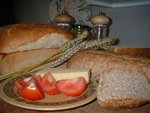
Quick and Efficient
The Back to basics Grain Mill makes about 1/2 cup of fine flour per minute and
more than twice that quantity on coarse setting. You will be delighted with the
results.
Economical Make your own delicious whole grain breads, cereals,
and other bakery items at a fraction of the cost of store-bought. Save money,
while providing fresher, healthier foods.
Convenient The Back to Basics
Grain Mill stores easily in a drawer or cupboard and is always handy when you
need it. Guaranteed for two years against defects in materials and workmanship.

|
The
Brow Farm Back To Basics Grain Mill / Wheat Grinder - Hand Crank
£43.25
Whole
grains contain natural fibers, vitamins and minerals needed to maintan vibrant
health. Now there's a simple way to replace overly processed, vitamin deficient
foods with the fresh, natural goodness of home-ground products. Create an infinite
variety of new textures and flavors in home baking, cereals, snacks, beverages
and desserts with the Back to Basics Grain Mill!
The Secret The secret
of the Back to Basics Grain Mill is in the milling mechanism. The cone-shaped
grinding burrs are self aligning, made of cast stainless steel, and are precision
machined to insure long life and smooth, even milling.
Versatile The
Back to Basics Grain mill grinds wheat, corn, rice, oats, barley, peppercorns,
and other dry grains and apices. The mill is adjustable for any desired texture
from fine to coarse.
|
|
What’s
In A wheat Grain?
To understand the benefits associated with milling
grain, you need to understand what comprises a whole grain. There are three main
layers: the bran, the germ, and the endosperm.
• The bran is the outer layer
where all the roughage that helps move unwanted poisons and toxins through your
system is found. The bran also contains numerous vitamins, minerals, and proteins.
• The germ is the health center of the grain, overflowing with vitamins B
and E, as well as unsaturated fat and protein.
• The endosperm is the starchy
white center. Whole grains contain almost 90% of all the vitamins, minerals, and
protein you’ll ever need. However, commercially milled products don’t offer you
those nutrients. Why? Once milled, the oils found in the bran and germ oxidize
and turn rancid within 72 hours. So for commercial purposes, both the bran and
germ—and all the nutrients contained within them—must be removed in order to give
products a shelf life.
Bread
Is Made of What?
The endosperm is all that’s left of the original grain.
So you’re basically eating gluten and starch when you eat products off the shelf.
For PR purposes, you’ll see breads and cereals claiming to be “enriched with vitamins
and minerals!” Don’t be fooled. The fact that a product needs enriching is a sign
of how much of its health value has been diminished. Usually only 2-4 of the missing
vitamins and minerals can be replaced anyway, and nothing can be done to replace
the fiber and protein.
Health
Benefits
Although the nation is currently experiencing low-carb mania,
fresh whole grain products are in fact good for you. They are low in fat, high
in protein, and provide energy for your muscles and body. High fiber found in
whole grains helps in the management of obesity, diabetes, hemorrhoids, stroke,
and heart attacks. Eating whole-grain foods on a regular basis has been shown
to decrease risk for heart disease and high cholesterol levels, and is also thought
to lower the risk of breast and colon cancer. Most commercial products reek with
preservatives, and bleaching agents. When milling your own flour, you’re able
to mill only the amount you need, so nothing goes to waste and you are left with
fresh-tasting, chemically unaltered flour.
Taste
After eating bread prepared from grain you mill yourself, there is no going back.
Commercial products will taste stale, even if they’re “fresh” off the shelf. Freshly
milled breads can have a variety of taste depending on which grains you chose
to mill. There’s fun in experimenting with different grains in your recipes. Try
adding or combining buckwheat, spelt (good for people with wheat allergies), oats,
rye, wheat, quinoa, millet and many other grains for a never-ending variety of
taste.
Time
Question: Does milling and baking your own grains take a little longer than grabbing
a loaf off the shelf? Answer: Yes. But not that much longer, and the payoff in
taste and health benefits more than makes up for it. Don’t let yourself be intimidated
by the thought of milling your own grain. These days, grain mills come in a variety
of sizes, are simple to use, and are adaptable to the average household, meaning
you can buy big or small units depending on your needs. Plus, they eventually
pay for themselves in money saved on buying commercial products.
Getting
Started
Today when we struggle to find time to fit in the washing, walking
the dog, get the kids to rugby and football practice, the suggestion we mill our
own grain may sound far-fetched. But today’s grain mills make the process easy,
and the benefits associated with milling your own grain are tangible and ongoing.
Investigate different types of grain mills, or find a friend or co-worker who
owns one and ask to give it a whirl. Experiment with a recipe or two, and you’ll
quickly understand why so many people are choosing to take the time to pamper
themselves with freshly milled, homebaked goodness.



